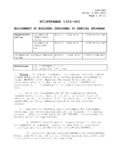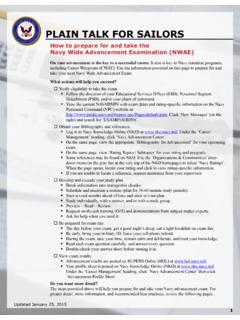Transcription of AFSC 1B4X1 CYBER WARFARE OPERATIONS
1 DEPARTMENT OF THE AIR FORCE Headquarters US Air Force Washington, DC 20330-1030 CFETP 1B4X1 Parts I and II 15 July 2018 AFSC 1B4X1 CYBER WARFARE OPERATIONS CAREER FIELD EDUCATION AND TRAINING PLAN ACCESSIBILITY: Publications and forms are available on the e-publishing website at for downloading or ordering. RELEASABILITY: There are no releasability restrictions on this publication. 2 CAREER FIELD EDUCATION AND TRAINING PLAN CYBER WARFARE OPERATIONS AFSC 1B4X1 TABLE OF CONTENTS PART I Preface ..4 Abbreviations/Terms Explained ..5 Section A - General Information ..10 Purpose of the CFETP Use of the CFETP Coordination and Approval of the CFETP Section B - Career Field Progression and Information ..12 Specialty Description Skill/Career Progression CYBER WARFARE OPERATIONS Apprentice (1B431) CYBER WARFARE OPERATIONS Journeyman (1B451) CYBER WARFARE OPERATIONS Craftsman (1B471) CYBER WARFARE OPERATIONS Superintendent (1B491) 1B4X1 Career Path Chart Training Decisions Community College of the Air Force Academic Programs Career Field Path 1B4X1 CYBER WARFARE OPERATIONS Career Path Table Section C - Skill Level Training Requirements.
2 22 Purpose Specialty Qualification Requirements Apprentice (3-Level) Training Journeyman (5-Level) Training Craftsman (7-Level) Training Superintendent (9-Level) Training Section D - Resource Constraints ..26 Purpose Apprentice (3-Level) Training Journeyman (5-Level) Training Craftsman (7-Level) Training Superintendent (9-Level) Training Section E - Transition Training Guide ..26 3 Part II Section A - Specialty Training Standard ..27 Section B - Course Objective List ..53 Section C - Support Materials ..53 Air Force Job Qualification Standards and Air Force Qualification Training Packages Section D - Training Course Index ..53 Purpose Air Force In-Residence Courses Air University Courses Exportable Courses Section E - MAJCOM-Unique Requirements ..53 OPR: 333 TRS/TRR Approved By: CMSgt Robert J.
3 Agard AFCFM (SAF/CIO A6SF) Supersedes: CFETP 1B4X1 , dated 01 November 2014 Pages: 53 4 CAREER FIELD EDUCATION AND TRAINING PLAN CYBER WARFARE OPERATIONS AFSC 1B4X1 PART I Preface 1. This Career Field Education and Training Plan (CFETP) is a comprehensive education and training document that identifies life-cycle education/training requirements, training support resources and minimum core task requirements for this specialty. The CFETP will provide personnel a clear career path to success and instill rigor in all aspects of career field training. 2. The CFETP documents the career field training program and consists of two parts. Management uses both parts in conjunction with Training Business Area (TBA) to plan, manage and control training within the career field. NOTE: Civilians occupying associated positions will use Part II to support duty position qualification training.
4 Part I provides information necessary for overall management of the specialty. Section A explains how everyone will use the plan; Section B identifies career field progression information, duties and responsibilities, training strategies and career field path; Section C associates each level with specialty qualifications (knowledge, education, experience, training and other); Section D indicates resource constraints ( , funds, manpower, equipment, facilities); and Section E identifies transition training guide requirements for SSgt through MSgt. Part II includes the following: Section A identifies the Specialty Training Standard (STS) and includes duties, tasks, Training References (TRs) to support training, AETC-conducted training, wartime course and core task and correspondence course requirements.
5 Section B contains the Course Objectives List (COL) and training standards supervisors will use to determine if Airmen satisfied training requirements. Section C identifies available support materials ( , Qualification Training Package, which may be developed to support proficiency training). Section D identifies a training course index supervisors can use to determine resources available to support training. Included here are both mandatory and optional courses; and Section E identifies MAJCOM-unique training requirements supervisors can use to determine additional training required for the associated qualification needs. At unit level, supervisors and trainers will use Part II to identify, plan and conduct training commensurate with the overall goals of this plan. 3. Use of the guidance provided in this CFETP provides the foundation for effective and efficient training for individuals in this career field at the appropriate points in their careers.
6 This plan enables the Air Force to train today's work force for tomorrow's jobs. 5 Abbreviations/Terms Explained This section provides a common understanding of the terms that apply to the CYBER WARFARE OPERATIONS CFETP. Advanced Training (AT). A formal course of training that leads to a technical or supervisory level of an Air Force Specialty (AFS). Training is for selected Airmen at the advanced level of an AFS. Air and Space Expeditionary Force (AEF). The AEF is the Air Force s methodology for organizing, training, equipping, and sustaining rapidly responsive air and space forces to meet defense strategy requirements. Through the AEF, consisting of enabler and tempo banded capabilities the Air Force supports defense strategy requirements using a combination of both permanently assigned and rotational (allocated) forces.
7 Air Education Training Command (AETC). Responsible for the recruiting, training and education of Air Force personnel. AETC also provides pre-commissioning, professional military and continuing education. Air Force Career Field Manager (AFCFM). Representative appointed by the respective HQ USAF Deputy Chief of Staff or Under Secretariat to ensure that assigned Air Force specialties are trained and utilized to support Air Force mission requirements. Air Force enlisted Classification Directory (AFECD). The official directory for all military enlisted classification descriptions, codes, and identifiers. Establishes the occupational structure of the Air Force enlisted force. The occupational structure is flexible to permit enlisted personnel to specialize and develop their skills and abilities while allowing the Air Force to meet changing mission requirements.
8 Individual enlisted personnel have a joint responsibility with commanders and supervisors at all levels to fully develop their abilities consistent with Air Force needs and within the established patterns of specialization. Air Force Job Qualification Standard (AFJQS). A comprehensive task list that describes a particular job type or duty position. Supervisors use the AFJQS to document task qualification. The tasks on AFJQSs are common to all persons serving in the described duty position. Air Force Qualification Training Package (AFQTP). An instructional course designed for use at the unit to qualify or aid qualification in a duty position, program, or on a piece of equipment. It may be printed, computer-based, or other audiovisual media. Air Force Specialty (AFS). A group of positions (with the same title and code) that require common qualifications.
9 Air Force Tactics, Techniques and Procedures (AFTTP). AFTTPs describe the proper employment of specific Air Force assets, individually or in concert with other assets, to accomplish detailed objectives. Air University Associate-to-Baccalaureate Cooperative (AU ABC). Allows Airmen to turn a Community College of the Air Force Associates Degree into a Bachelor s Degree from an accredited university. The ABC program has established a partnership with various civilian higher-education institutions to offer four-year degree opportunities via distance learning. The participating schools will accept all of the credits earned by Airmen who have attained a CCAF degree and apply them to a Bachelor s degree related to their Air Force specialty. Air University/AFCDA (Air Force Career Development Academy).
10 The result of a reorganization of Air Force Institute for Advanced Distributed Learning (AFIADL); provides access to the Extension Course Institute. 6 Career Field Education and Training Plan (CFETP). A CFETP is a comprehensive core training document that identifies: life-cycle education and training requirements; training support resources; and minimum core task requirements for a specialty. The CFETP aims to give personnel a clear path and instill a sense of industry in career field training. CFETPs are officially posted at Certification. A formal indication of an individual s ability to perform a task to required standards. Chief enlisted Manager (CEM). Chief Master Sergeants that have extensive experience and training, and demonstrated managerial ability to plan, direct, coordinate, implement, and control a wide range of work activity.












